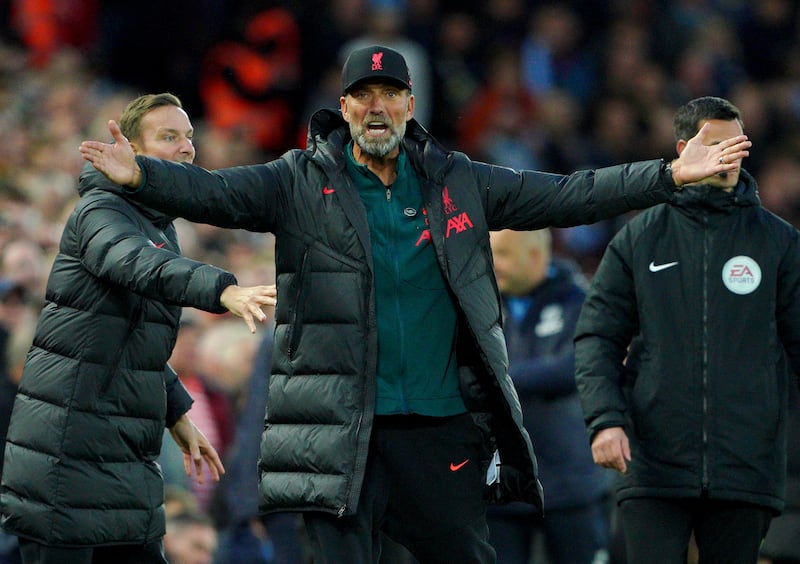Night. The man looks back over his shoulder, mouth open in horror. Too numb to offer more than token resistance, he acquiesces as his assistant ushers him away. “Forget it, Pep,” he says, “It’s Chinatown.” Street lights flare as the camera pans back. A policeman shouts. As sirens wail, a mournful saxophone tremors through the darkness. It’s one of the great endings: our hero has done what he can, but this is a place where he cannot win, a place governed by forces far stronger than him, a place with its own laws. This is Anfield.
On Sunday, after Manchester City’s 1-0 defeat by Liverpool, Pep Guardiola repeated the phrase over and over: “This is Anfield.” He said it to the written press. He said it to the radio. He said it to Sky and he said it to the BBC. “This is Anfield.” And his point was clear: you cannot win here. Certainly he struggles: Guardiola has won once at Anfield, but that was during lockdown when the stands were empty. On the seven occasions he has led a team there with fans, Guardiola has managed two draws and five defeats.
But this was not a tribute to the inspirational qualities of the Kop. Rather the implication, given he kept uttering the phrase in relation to the controversy surrounding City’s disallowed goal, was that referees are influenced at Anfield – which didn’t make a huge amount of sense given that the critical part of the decision had been given by the VAR official at Stockley Park, and that it was correct.
The line parroted by a number of City players was that Anthony Taylor had let a lot go. He had pursued this season’s Premier League guidelines on encouraging a more robust style of football, allowing moments of contact. Why then, in this instance, make an exception? Why not allow this contact?
READ MORE
To which there are two obvious responses. First, that to allow some contact is not allow all contact and that, given the way VAR is employed, a stricter interpretation is always likely in the immediate build-up to a goal. And second, that a pull on the shirt is not a shoulder-to-shoulder challenge, it’s not two players grappling for the ball, it’s not a slight brush of the leg as a tackle comes in. A shirt pull is never a legitimate way of winning the ball and, more than that, it shows up very clearly on video.
Erling Haaland grabbed Fabinho’s shirt and that is a foul. It doesn’t matter that Fabinho may have been toppling anyway. It doesn’t matter that Taylor’s view was obscured. It doesn’t matter that sometimes you’ll get away with that sort of thing. It was a foul – and so, the officials later said, was the subsequent Haaland challenge on Alisson: even had the pull on Fabinho not been penalised, the goal would have been ruled out. And amid all the City hysteria, it’s perhaps worth pointing out that the whole move began with a goal-kick that should have been a Liverpool corner.

It was a day of frenzied touchline behaviour. Jürgen Klopp also found himself enraged by the refereeing and that the incident that led to his red card was the third foul on Mohamed Salah to be ignored does not excuse his eruption. And nor, of course, is there any excusing the coins reportedly thrown by fans at Guardiola. That Klopp should serve a touchline ban and that any missile-throwers should be prosecuted is obvious.
But in terms of the season as a whole, it was Guardiola’s behaviour that fascinated. This has been a rivalry largely unsullied by the sort of psychological press-conference warfare that characterised his feud with José Mourinho in Spain. This is still, clearly, a long way from that. But Guardiola seemed on edge from the frosty prematch handshake, long before his gestures to the crowd after Phil Foden’s goal had been ruled out.
Perhaps that was just the Anfield factor, but it was hard not to wonder whether Klopp’s comments on Friday about the long-term impossibility of competing with state projects had touched a nerve, less perhaps in terms of a pang of conscience about the nature and purpose of the government funding his project, than the suggestion that he is playing the Premier League on an easier mode.
[ Ken Early: Manchester City-Liverpool rivalry enters new, more aggressive phaseOpens in new window ]
And it was hard not to see this season’s first spin of Guardiola’s tactical kaleidoscope in that context. Gone were the slight tweaks to the usual 4-3-3 and here instead was a wholly unexpected shape, with João Cancelo playing high on the right and Phil Foden dropping relatively deep on the left, a position that meant he was never able to expose James Milner at right back in the way he had in the equivalent fixture last season.
If the aim, by offering a de facto back three, was to shore up City’s defences against the counter – a vulnerability the greater verticality required to service Haaland has heightened – it failed: Salah had already been denied in a one-on-one when he scored, and Darwin Núñez led two late breakaways.
That there were defensive weaknesses beyond Haaland’s remarkable goals return had been exposed by Newcastle and Crystal Palace. But defeat at Anfield hinted at other flaws. Those issues against the counter are probably more a factor in the latter stages of European competition than the Premier League but, if Guardiola is feeling the pressure, if this is more than an Anfield issue, it may be as well for City that this week’s scheduled game against the leaders Arsenal has been rearranged. Perhaps it’s just Anfield, but perhaps it’s more than that. — Guardian














